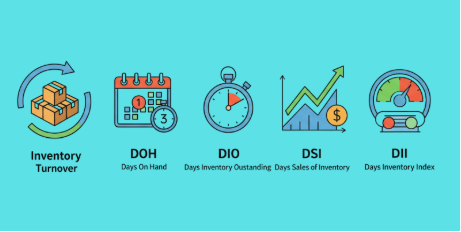Sandbox
Inventory Turnover, DOH, DIO, DSI & DII: What They Really Mean for Your Business.

If you question whether your inventory sells quickly or just stays on shelves as dead stock, you are not alone. All businesses face the same issues. To resolve this and to tell if your inventory is in good condition or not, metrics like Inventory Turnover, Days on Hand (DOH), Days Inventory Outstanding (DIO), Days Sales of Inventory (DSI), and Days Inventory Investment (DII) can be used.
Inventory Turnover
Inventory turnover is basically how many times you sell and replace your inventory during a year. (Formula: Inventory turnover = Annual Cost of Goods Sold (COGS) / Average Inventory) For example, let's say your annual COGS is $1 million, and average inventory is $200K. Then, the inventory turnover is 5 turns (1,000,000 / 200,000). In other words, your business sells through its inventory five times a year.DOH (Days of Inventory on Hand)
If turnover tells you how many times stock moves in a year, DOH tells you how many days inventory is sitting before it’s being sold. (Formula: DOH = 365 / Inventory Turnover)For example: If turnover is 5 as above example, then DOH is 73 days (365/5). Therefore, on average, your inventory stays in stock for about two and a half months.
DIO, DSI, and DII: Different Names, Same Concept
You’ll often hear other acronyms for the same calculation: DIO (Days Inventory Outstanding), DSI (Days Sales of Inventory), DII (Days in Inventory) but basically these are the same as DOH. All refer to the average duration that inventory remains before being sold. Using the example above, all of them come out to 73 days.Why These Numbers Matter
The numbers show more than just accounting terms; they tell a story about your business.1/ About cash flow - When inventory moves fast, a small amount of cash stays in unsold products.
2/ To control costs - Holding inventory for a small number of days helps cut expenses for storage, insurance along with other holding fees.
3/ About business risks - A slow turnover rate could show problems such as too much stock, bad forecasts, or weak demand.
Consider them a regular check of your inventory. When the numbers are good, operations are easy and cash flow is better.
The purpose of DOH, DIO, DSI, or DII, is to learn about your inventory turnover speed. With inventory turnover together, you get a good view of operations and reach a good decision.

